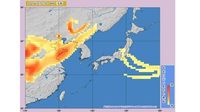Japan is currently experiencing significant yellow sand events, with the Japan Meteorological Agency (JMA) reporting observations across major cities like Tokyo and Osaka on March 26, 2025. This phenomenon has raised concerns about visibility and potential disruptions to daily life.
According to the JMA's Yellow Sand Information, both Tokyo and Osaka recorded visibility levels between 5 and 10 kilometers on this day, prompting officials to advise caution due to possible traffic disruptions. The agency's Yellow Sand Analysis Forecast Map indicated that yellow sand covered a broad area of Japan, excluding Hokkaido and Okinawa, in the morning hours of March 26. However, by the evening, this area began to gradually shrink.
As the weather continues to evolve, the JMA has warned that on March 27, thin layers of yellow sand may still affect regions such as Shikoku, the Kinki area, Hokuriku, the East Sea, Kanto-Koshin, and parts of Tohoku. This necessitates ongoing vigilance as the sand could impact visibility and health.
In the Tohoku region specifically, the Sendai Regional Meteorological Office issued its second report on yellow sand on March 26, 2025, at 09:31. It confirmed the presence of yellow sand and noted that visibility in some areas had dropped below 10 kilometers. The forecast suggested that conditions would persist, with visibility potentially falling to under 5 kilometers in certain locations.
As of 08:00 on March 26, preliminary visibility readings were recorded as follows: Yamagata at 8 kilometers, Sendai at 8 kilometers, and Fukushima at 6 kilometers. These conditions have raised alarms about the effects of yellow sand, which include reduced visibility, the soiling of laundry and vehicles, and possible health impacts.
Furthermore, the JMA cautioned that the arrival of yellow sand from the continent should be monitored until the morning of March 27, 2025. The forecast also indicates that rain is expected, influenced by a front extending from a low-pressure system, which may help alleviate some of the yellow sand's effects.
On March 27, particularly in Tottori Prefecture, a high concentration of yellow sand is anticipated. Residents are advised to prepare for noticeable accumulation on cars and laundry. The JMA has directed individuals seeking more information to its website for the latest updates and detailed forecasts.
As this weather phenomenon unfolds, the JMA continues to emphasize the importance of staying informed about the latest weather conditions. Residents across affected regions are encouraged to take precautions to protect their health and property from the adverse effects of yellow sand.
In summary, yellow sand is a recurring issue for Japan, particularly during certain seasons, and this recent event underscores the need for public awareness and preparedness. As weather patterns shift, the impact of yellow sand can vary, making it crucial for residents to remain vigilant and informed.






